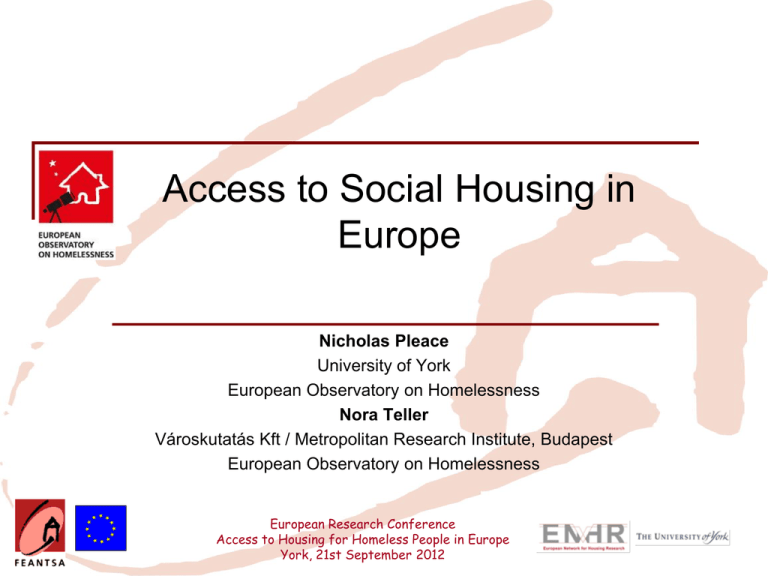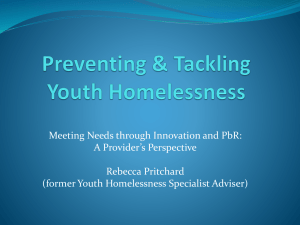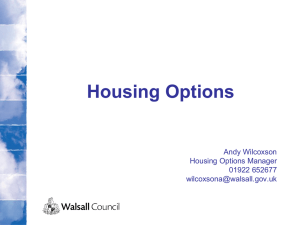Presentation (MS PowerPoint , 524kb)
advertisement

Access to Social Housing in Europe Nicholas Pleace University of York European Observatory on Homelessness Nora Teller Városkutatás Kft / Metropolitan Research Institute, Budapest European Observatory on Homelessness European Research Conference Access to Housing for Homeless People in Europe York, 21st September 2012 About the research Comparative research is always rather difficult Direct comparison of apparently quite similar countries not straightforward Variation in definitions (in this instance ‘social housing’ and ‘homelessness’) Some EU societies with centralised systems, others massively devolved which means its not just a matter of differences at national level, a single country can be highly varied WE and CEE comparison complicates the situation further Expert questionnaire approach – iterative process Not perfect, because reliant on a few experts who may vary in knowledge and skills But allows standard questions using standardised definitions European Research Conference Access to Housing for Homeless People in Europe York, 21st September 2012 Summary of definitions Talking about homelessness in the sense of literally being on the street and people who are in accommodation that they cannot reasonably be expected to occupy (physical conditions such as poor repair and overcrowding, security of tenure) - ETHOS Talking about publicly subsidised bricks and mortar, i.e. physical housing and not welfare benefits designed to enable poorer people to meet the costs of renting privately - FEANTSA European Research Conference Access to Housing for Homeless People in Europe York, 21st September 2012 Coverage Thirteen experts recruited through European Observatory on Homelessness Belgium (focusing specifically on Flanders), Bulgaria, the Czech Republic, Finland, France, Germany, Ireland, the Netherlands, Poland, Portugal, Sweden, Spain and the UK. Data on both social housing and homelessness much better in some countries than others, concentrating here on Belgium, Finland, France, Germany, Ireland, Netherlands, Sweden and UK European Research Conference Access to Housing for Homeless People in Europe York, 21st September 2012 Key questions Why does homelessness exist in welfare systems with social housing? Contrasting views Individual pathology and homelessness causation ‘Barriers’ to social housing Supply shortfalls Lack of coordination of social and housing services European Research Conference Access to Housing for Homeless People in Europe York, 21st September 2012 Social housing does not tackle homelessness because of the ‘nature’ of homelessness Homelessness ‘caused’ by individual characteristics Three levels Homeless people are a ‘sick’ population, characterised by mental health problems, problematic drug and alcohol use Choices to become/remain homelessness, sometimes referencing ideas of ‘thin rationality’/’survival’ Homelessness as a culturally distinct state (similar logic to negative area effects) Nature of homelessness creates a kind of ‘avoidance’, a difficulty in engaging with welfare systems, homeless people as ‘distinct’ from cultural, economic and social mainstream European Research Conference Access to Housing for Homeless People in Europe York, 21st September 2012 Problems with Individual Pathology Argument that homelessness is caused by support needs and individual choice is problematic Three sets of evidence Broad associations with welfare systems, more extensive welfare systems have less homelessness Evidence of groups (such as homeless families) who are not characterised by high support needs and who seem largely undifferentiated from the poor population Evidence that the high cost/high risk ‘chronic’ homeless group are a minority in a larger, transitional population of emergency accommodation users ‘Neo-Liberal’ interpretations of homelessness are popular with politicians because they make the issue a matter of ‘individual choice’ or ‘illness’ rather than due to labour market, housing market and welfare system cuts or failures European Research Conference Access to Housing for Homeless People in Europe York, 21st September 2012 Shortfalls in supply of affordable and adequate housing There are simply not enough affordable homes of adequate standard Difficult to dispute, this is recognised as a strategic problem across much of the EU Whether one interprets this as an issue of social housing supply depends on perspective Social housing is not in fashion, seen as expensive, as ‘distorting’ housing markets and as creating social problems by generating spatial concentrations of poverty European Research Conference Access to Housing for Homeless People in Europe York, 21st September 2012 Social landlords avoid housing homeless people Reduction in investment in bricks and mortar in many developed welfare systems which creates rationing (but not all) Popular and cultural images of homeless people as likely to be ‘difficult’ tenants, causing management problems like anti-social behaviour, not paying the rent Rise of social enterprise/private finance, reliance on bank lending to develop requires working tenants who will reliably pay (and can afford) rent that provides economic return Negative area effects/’workless’ places. Social landlords under direction to avoid spatial concentration of poverty in urban space. Homeless people are poor. Homeless people may need additional social work and health services, typically not offered by landlords. European Research Conference Access to Housing for Homeless People in Europe York, 21st September 2012 Background: Social Housing European Research Conference Access to Housing for Homeless People in Europe York, 21st September 2012 Background: Homelessness Don’t know exact numbers with a very few exceptions Hard to measure because often a transitional state On-going attempts to standardise EU level data to get an overview Latest attempt to coordinate data collection, ensure minimum standards, ensure any data collection MPHASIS and guidance on counting homelessness 2011 Censuses have not worked Key issues are agreeing definition, raising political profile in Southern and Eastern countries which have much bigger social problems to worry about Know it is there, know something about its shape, cannot be precise, almost certainly hundreds of thousands European Research Conference Access to Housing for Homeless People in Europe York, 21st September 2012 Barriers: Resources Inadequate supply of all forms of adequate affordable housing consistently reported across all 13 countries Reflected in national strategic concerns UK has been struggling to find an economic way to deliver affordable housing supply for decades Insufficient social housing supply and location of available stock outside areas of high demand Taking UK as example again, far less demand for social housing in the North and parts of the Midlands that in London and Home Counties But the modernist urge that created some social housing policy movements is fading (and it was not present elsewhere), social housing is also very expensive, it is unfashionable European Research Conference Access to Housing for Homeless People in Europe York, 21st September 2012 Barriers: Homeless people as ‘difficult’ tenants Widespread belief among social landlords that homelessness was always associated with severe mental illness and problematic drug/alcohol use, chaotic behaviour, sustained worklessness, low level criminality A reluctance to house homeless people when support needs were present because of a concern that support workers, health, social care, psychiatric and drug and alcohol services would either not be put in place or would only be provided on a short-term basis European Research Conference Access to Housing for Homeless People in Europe York, 21st September 2012 Barriers: Marketization Some evidence of homeless people as bad financial risk, expensive to manage, too poor to afford financially viable rents and disproportionately likely to go into rent arrears But this was related to the nature of the social housing system Marketization and a growing focus on enterprise role in the Netherlands had been ‘rolled back’ by Government in response to financial crisis, social landlords told to ‘re-focus’ on housing need Sweden has seen a near-’commercialisation’ of former social housing UK has seen ever greater role for private investment since 1988 legislation introduced the New Financial Regime But returns to pay off private loans/investment not present everywhere European Research Conference Access to Housing for Homeless People in Europe York, 21st September 2012 Barriers: Area Effects Social landlords were under legal obligation, directives or guidance at national, regional and/or local level to avoid spatial concentrations of poverty A ‘culture of worklessness’ within poor areas that was presumed to exacerbate social, cultural and economic marginalisation, criminality of the populations in those areas, sometimes intermixed with anxiety about Muslim population concentration But seemingly an anxiety of Northern European Capitalism...Belgium, Finland, France, Germany, Netherlands, Ireland, UK, not the South or the East European Research Conference Access to Housing for Homeless People in Europe York, 21st September 2012 European Research Conference Access to Housing for Homeless People in Europe York, 21st September 2012 Barriers: Not in the Design Social housing often predates the relatively modern “recognition” that a state of homelessness and a subgroup of ‘homeless people’ could exist Often been a concern to address housing need, but social housing is often not specifically designed to address homelessness Homelessness exists, but social housing was originally built to do other things European Research Conference Access to Housing for Homeless People in Europe York, 21st September 2012 Barriers: Not in the Design Social housing is generally not designed specifically to tackle homelessness or all forms of acute housing need It was – and is – designed to do other things, urban renewal, slum replacement or shanty clearance, encourage local enterprise through increasing affordable housing supply, house ‘keyworkers’, address child poverty etc etc Homelessness may be quite a way down the agenda for social landlords With the exception of many poor families containing children, who tend to be able to access social housing when in housing need, just as they often have enhanced access to welfare systems European Research Conference Access to Housing for Homeless People in Europe York, 21st September 2012 Barriers: Coordination Poor strategic coordination Social housing seems to have often developed separately rather than be integrated within wider welfare systems Housing does not tend to be regarded as a ‘welfare’ service in the way that social work or health services are There are countries that respond to homelessness with a raft of specific policy interventions and service models, including health and social work or treatment-led models, effectively adopting the ideas of individual pathology rather than looking towards social housing as providing an answer (the UK is one obvious exception to this, France to a lesser extent) European Research Conference Access to Housing for Homeless People in Europe York, 21st September 2012 Conclusions The presence of high levels of social housing does not predict low levels of homelessness, so homelessness is not necessarily made into a smaller social problem by extensive social housing provision (Portugal @ 15%, Ireland @ 15%) But if we look at welfare-rich systems and here there is some (limited) evidence to suggest that universal access to minimum income, welfare benefits to meet housing costs, do appear to significantly reduce overall homelessness, particularly transitional homelessness among low-need groups European Research Conference Access to Housing for Homeless People in Europe York, 21st September 2012 Conclusions The barriers to social housing are significant, according to the respondents there was often not enough of it and it could be problematic for some groups of homeless people to access Social housing remains a major resource, it certainly can be used to reduce homelessness and, where it offers better standards, to counteract the - now once again growing - relationship between income poverty and poor housing/housing exclusion. In this sense, problems with social housing supply and with access to social housing may well make homelessness worse than it would otherwise be. European Research Conference Access to Housing for Homeless People in Europe York, 21st September 2012 Conclusions The relative neglect of social housing reflects – in some societies – this unfashionable ‘expensive’ and ‘antimarket’ way of dealing with housing need, it is also associated with negative area effects, social problems It also reflects the cultural status of social housing as an undesired tenure in some societies A clearer emphasis on homelessness and housing need could help re-focus social housing policy, give it a clearer role, but there is massive ideological resistance to nonmarket led responses to homelessness or housing need, despite the self-evident failure of housing markets to adequately meet housing need European Research Conference Access to Housing for Homeless People in Europe York, 21st September 2012 Thanks for listening Nicholas Pleace, Centre for Housing Policy, University of York nicholas.pleace@york.ac.uk Nora Teller, Városkutatás Kft / Metropolitan Research Institute, Budapest teller@mri.hu European Observatory on Homelessness http://www.feantsaresearch.org/ European Research Conference Access to Housing for Homeless People in Europe York, 21st September 2012









